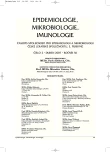Pertussis: a Reemerging Infection?
Authors:
B. Kříž 1,2; K. Fabiánová 1; M. Maixnerová 2; Č. Beneš 1; M. Malý 1
Authors‘ workplace:
Státní zdravotní ústav, Praha
1; Univerzita Karlova, 3. lékařská fakulta, Praha
2
Published in:
Epidemiol. Mikrobiol. Imunol. 56, 2007, č. 2, s. 51-65
Overview
Study objectives:
To analyze the incidence of pertussis in the Czech Republic, influencing factors and, in particular, the effect of vaccination on pertussis morbidity, clinical seriousness of the disease and circulation of Bordetella pertussis in the population. To study the causes of defective diagnosis and reporting and to propose remedial measures.
Methods:
Data on pertussis morbidity were obtained from the archives of the National Institute of Public Health and the public health information systems ISPO and EPIDAT. Mortality data were taken from the above sources and literature. The case definition was used as specified in the Methodical Guidance for Pertussis Surveillance and the EC Directive. Laboratory diagnosis was based on culture and serology. An at least fourfold increase in the serum antibody titer found within an experiment was considered as a positive result.
Results:
Pertussis together with diphteria and measles used to be among the most dangerous infections in childhood. The oldest mortality data date back to 1890 when 62 deaths per 100,000 population were reported. In 1951, the death rate still reached 3.6/100,000. The pertussis morbidity peaked in 1955 with 540 cases per 100,000 population. Vaccination against pertussis since the early 1950’s led to a rapid reduction of morbidity in children. Nevertheless, higher pertussis morbidity rates were observed at 2–4-year intervals (in the so- called epidemic years). The lowest morbidity rates were reported during the 1980’s. However, a stable upward trend has been observed over the following years. In 2006, a neonate died from pertussis. The age specific morbidity rates in 1980 through 2000 were highest in children under one year of age. This fact together with the regularly increased morbidity rates observed at 2–3-year intervals indicate that Bordetella pertussis still circulates in the population. While in the 1980’s, the cases of pertussis were reported almost exclusively in children under one year of age, in the 1990’s, they became more common also among children 1–4 years of age and started to be prevalent in children 10–14 years of age since 2001.
Conclusion:
A high immunisation coverage (97 %) with five doses of high quality whole-cell vaccine of Czech origin introduced into practice in 1958 played a crucial role in the reduction of pertussis morbidity from more than 500/100,000 in the mid-1950’s to less than 0.5/100,000 in the 1980’s. Nevertheless, this strategy did not lead to elimination of the causative agent in the population. It is evident that the current immunization scheme with the use of the available vaccines cannot solve the epidemiological situation. Since the efficacy of the currently available acellular pertussis vaccines is, at the best, the same as that of the whole-cell vaccines, any improvement of the current status cannot be expected. Only effective active surveillance, the use of new more immunogenic pertussis vaccines and revaccination of older age groups can result in desirable outcomes.
Key words:
pertussis – vaccine – surveillance – vaccine protective effect – immunogenicity – reactogenicity.
Labels
Hygiene and epidemiology Medical virology Clinical microbiologyArticle was published in
Epidemiology, Microbiology, Immunology

2007 Issue 2
Most read in this issue
- Monitoring Genes Encoding Panton-Valentine Leukocidin in Staphylococcus Aureus Strains
- Pertussis: a Reemerging Infection?
- Effectiveness of Aerial Application of VectoBac G Larvicide Granules Against Mosquitoes in the Olomouc Region in Spring 2006
- Clinical Specimens for PCR Detection of Syphilis
